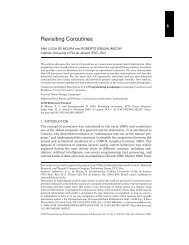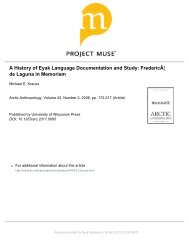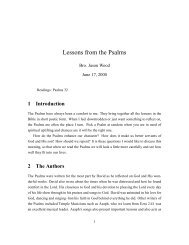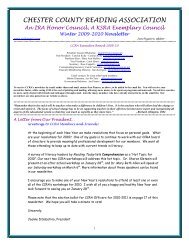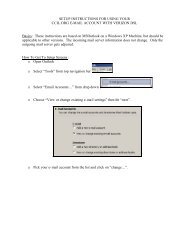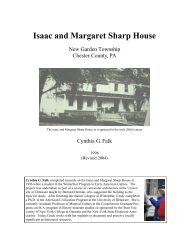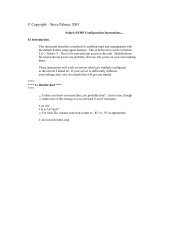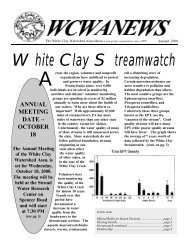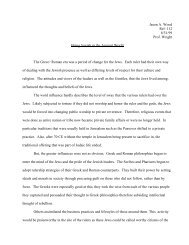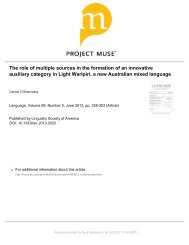You also want an ePaper? Increase the reach of your titles
YUMPU automatically turns print PDFs into web optimized ePapers that Google loves.
according to what types of segments they are based<br />
on – words, syllables, or consonants and vowels.<br />
Certain features of speech are associated with longer<br />
segments than others; for example, stress and intonation,<br />
which in many writing systems are not marked,<br />
are associated with stretches of speech such as the<br />
syllable, word, or sentence.<br />
Types of <strong>Transcription</strong><br />
A transcription can never capture all the nuances<br />
of speech. The amount of detail it attempts to<br />
include in its text will vary according to its purpose.<br />
A system intended for the specialist linguist investigating<br />
a language never previously studied would<br />
often need to allow the recording of as many as<br />
possible of the various nuances of sounds, pitch variations,<br />
voice quality changes, and so on. Such a<br />
transcription may be called ‘impressionistic,’ and<br />
is unlikely to be helpful to anyone other than a<br />
specialist.<br />
Proceeding from this initial transcription, the linguist<br />
can deduce the way in which the sound system<br />
of the language is structured, and can replace the<br />
impressionistic transcription with a ‘systematic’ one,<br />
which records in its text only the elements that are<br />
crucial for conveying the meanings of the language.<br />
This type of transcription may well form the basis<br />
for a regular writing system for that language, and is<br />
called a ‘phonemic,’ or ‘broad,’ transcription. For use<br />
in teaching the spoken language, however, it may be<br />
helpful to transcribe some of the subphonemic sound<br />
differences likely to present problems to the learner.<br />
This kind of transcription may be called ‘allophonic,’<br />
or ‘narrow.’ If detailed comparisons are to be made<br />
between this language or dialect and another one,<br />
showing the more subtle sound distinctions, the transcription<br />
may begin to resemble the impressionistic<br />
one, but as it is the result of a prior analysis, it will<br />
still be systematic. Conventions may be supplied to<br />
show the way in which the broad transcription is<br />
realized phonetically in certain environments. For<br />
special purposes, such as recording the speech of<br />
the deaf, very complex transcription systems may be<br />
necessary, to cope with sound variations that rarely<br />
occur in the speech of those without such a disability<br />
(see later, discussion of the International <strong>Phonetic</strong><br />
Association).<br />
Notation<br />
<strong>Transcription</strong> systems need to employ a notation that<br />
allows them to refer to a sound unambiguously. The<br />
following approaches utilize some of the principles<br />
followed in effective systems of notation:<br />
<strong>Phonetic</strong> <strong>Transcription</strong>: <strong>History</strong> 397<br />
1. To avoid ambiguity, each symbol used in the notation,<br />
in its particular environment, should be restricted<br />
to one particular sound or sound class<br />
(or, in some cases, groups of sounds, such as the<br />
syllable), and each sound, etc. should be represented<br />
by only one symbol. So, for instance, the<br />
symbol , which has different values in German<br />
and English orthography, would need to be confined<br />
to only one of those values. Conversely,<br />
the sound [s], which in English may be conveyed<br />
either by as in ‘supersede’ or as in ‘cede,’<br />
must be limited to only one symbol.<br />
2. The symbols used should ideally be simple, but<br />
distinctive in shape, easily legible, easy to write<br />
or print, aesthetically pleasing, and familiar to<br />
the intended users. If printing types are not<br />
readily available, the system will be limited in its<br />
accessibility and expensive to reproduce.<br />
3. If the transcription is to be pronounceable (not all<br />
kinds are required to be), the sound values of the<br />
symbols must be made clear, through a description<br />
of the ways in which the sounds are formed,<br />
or through recorded examples, or by ‘key words’<br />
taken from a language, provided that the accent<br />
referred to is specified. Some transcription systems<br />
include pieces of continuous text to illustrate the<br />
application to particular languages (e.g., those<br />
of Carl Lepsius and the International <strong>Phonetic</strong><br />
Association (IPA); see later).<br />
4. The symbol system should be expandable,<br />
particularly if it is intended to be used to cover<br />
all languages. As new languages are encountered,<br />
new varieties of sounds will have to be defined.<br />
Alphabetic Notations: Roman and Non-Roman<br />
Alphabetic notations (e.g., the Roman alphabet) are<br />
based on the principle of having one simple symbol<br />
to represent each segment. However, many transcription<br />
systems are not based on the Roman alphabet,<br />
because of the ambiguous values of some of its symbols,<br />
or because it has been found preferable to use<br />
‘iconic’ symbols, intended to convey by their shapes<br />
the phonetic nature of the sound concerned, and/or<br />
to link related groups of sounds. One variety of iconic<br />
notation has been called ‘organic,’ because the shapes<br />
of its symbols are meant to suggest the organs of<br />
speech used to produce them. Shorthand systems<br />
characteristically are non-Roman and iconic, but<br />
not necessarily organic. Iconic systems have a number<br />
of drawbacks. Apart from the difficulties of reading<br />
and printing them, they cannot be easily expanded<br />
to incorporate sounds newly encountered. It is also<br />
less easy to adapt them as and when phonetic theory<br />
undergoes changes.



